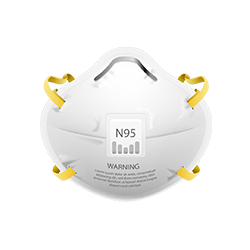The real challenge in Respirator Testing
We hear on the news that there are shortages of respirators for the front-line health care workers. But why do we all not deserve the same amount of safety?
Masks can be annoying to wear, give you an itchy nose, make it hard to breathe, and the regrettable mask-acne! So why wear them? For our safety, and to help slow down the spread of the COVID- 19 virus. We put ourselves through this to try and help, but we are still buying masks that have not been tested thus giving us a false sense of security when wearing them.
N95 masks got their “name” from the ‘N’, signifying that the mask is ‘Non-resistant to oil’ and the proceeding number indicating the minimum efficiency of the mask (95%). For this type of mask, less than 5% of particles can pass through the mask.
Particulate scientists have analyzed the behavior of particle filtering and have found that the best particle size for respirator testing is about 75 nm, or 75 millionths of one millimeter.
Interestingly, particles smaller than that move around so much just from their own heat that (compared to larger particles) they are more likely to collide with a filter fiber and get stuck. Particles smaller than 75 nm are also easier to catch with electrostatic filtering – a technique used in many modern facemasks.
The real challenge in respirator testing is to generate the correct particles for testing and measuring the particles that pass through the mask. Generating the salt crystals involves creating a special saltwater mist and drying out the tiny mist droplets in a particular way. The process is very sensitive, requiring a lot of attention to detail to keep the conditions in the right range.
Keeping particles in the right range is very important, since larger or smaller particles will tend to get captured more easily by the filter, making it appear better, in the test results, than it really is. To verify that the particles remain in the right range throughout the testing process, it is important to measure them somehow.
Measuring the sizes of these tiny particles is another big challenge for laboratories, because 75 nm is such a small size that objects that size cannot be seen, even with a world-class optical microscope.
This is because light waves themselves are closer to 500 nm in size, and do not interact in any usual way with the particles.
To address this issue, engineers have invented a variety of special tools and measurement devices that can pick out particles of different sizes and even count them!
This picking and counting can be a complicated process on its own but, in the end, is the most accurate known way to ensure the efficiency of masks.


